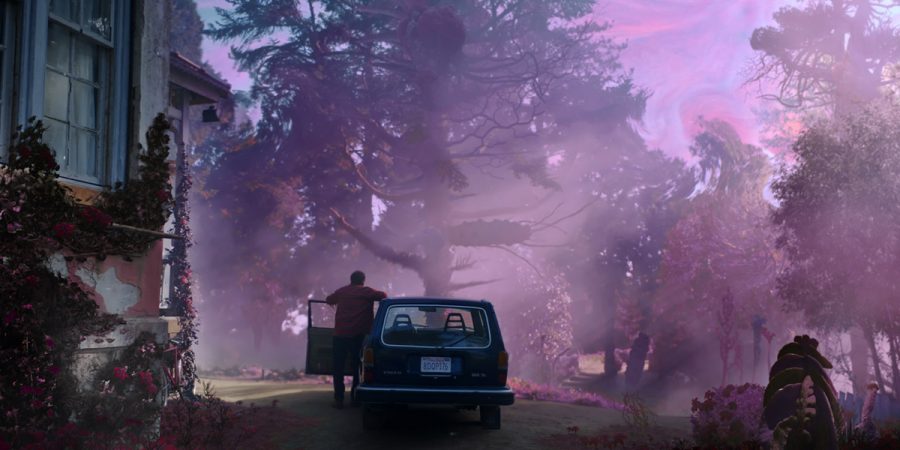Richard Stanley’s “Color Out of Space” is an adaptation of a 1927 story by H.P. Lovecraft and will probably garner a fanbase on this fact alone. Lovecraft is an author with an influence and name recognition that has only risen in the 83 years since his death. But Lovecraft’s mythology has been a pervasive influence on modern pop culture, with homages popping up in movies ranging from “The Lighthouse”to “Cabin in the Woods” to 2014’s “Godzilla.” His work has been referenced in “The Simpsons”and even the children’s cartoon “Scooby-Doo! Mystery, Inc.”
Recently, the novel “Lovecraft County” is currently being turned into an HBO series produced by Jordan Peele and J.J. Abrams and famed comic book writer Alan Moore wrote a comic book series dealing with Lovecraft’s work. Fan societies have made faithful low budget adaptations themselves and the internet is awash with parodies of his signature style and ideas. Director Richard Stanley commented on this phenomenon in a recent appearance on “The Movies That Made Me” podcast, saying of Cthulhu, “That meme has saturated contemporary culture. It’s instantly identifiable…Its tendrils have found its way everywhere…without any corporate power actually owning it or deliberately promoting it.” Weirdly though, Hollywood doesn’t seem to trust this popularity enough to risk money on it since there still hasn’t been a major studio movie dealing with the Cthulhu mythos, even acclaimed director Guillermo Del Toro wasn’t able to get his Lovecraft script produced. This is despite the fact that these stories are in the public domain, so any studio can adapt them for free. Lovecraft even created his own extended universe – the very thing that desperate corporations are trying to manufacture to rival Disney’s domination. Lovecraft himself was a horrible racist, which shouldn’t be ignored, but still, Cthulhu alone is an iconic creation deserving of adaptation.
All of which is to say that a modern adaptation like this, with a recognizable star – Nicolas Cage – has been a long time coming. But still, the popularity of Lovecraft’s work apparently isn’t enough to convince studios to bite because this is still a rather low budget affair: Stanley and co-writer Scarlett Amaris adapted a story set in one location for budgetary reasons and could only get the movie financed by Elijah Wood and Daniel Noah’s SpectreVision, which specializes in horror movies that are independent and off-kilter. For fans hoping for a more expansive adaptation of the Cthulhu Mythos, this movie is worth championing as a stepping stone toward that goal, especially since it’s a largely effective and fun horror movie on its own merits.
The plot is fairly simple: a farmhouse in which Nathan Gardner (Cage) and his family reside becomes the landing place for an asteroid. The asteroid emits a bizarre purple glow, and then chaos ensues for the family and nearby wildlife. The plot is an effective enough spine for some great sequences, though the movie’s early scenes are a bit dull – the family dynamics have been done in other movies and the dialogue is often cliché; these characters lack the type of idiosyncrasies that deepen horror movies like Ari Aster’s “Hereditary.” But when the supernatural elements become more intense, the movie gets more engaging, particularly when Cage starts making acting choices that nobody else would ever make.
These moments will make some viewers recall 2017’s “Mandy,” which also starred Cage and was also produced by SpectreVision. “Color Out of Space”suffers a bit by the comparison, since this movie never gets as wild as “Mandy” did. Not that it doesn’t try, though, there are several scares and gross-out-gags that, while a bit more schlocky than a really faithful Lovecraft adaptation would be, are effective, surprising and mesh well with the truly singular energy Cage has in this movie.
The entire movie is visually stimulating with purple being used well as a motif and dinosaur toys being used to express the fact that – as in all Lovecraft stories – that they are ancient forces at work. Direct Lovecraft references like the Miskatonic University shirt worn by Elliot Knight’s Ward Phillips are nice touches too. But the movie becomes more memorable with some beautiful final images.
Amherst Cinema only screened “Color Out of Space”at 9:45 p.m. (as it did for “Mandy”) implying that this is being viewed as a cult, midnight movie in the making. The movie has the right ingredients to make this prediction come true, even if some Lovecraft fans might leave the theater wishing they had gotten more.
Caleb Coyne can be reached ca [email protected].



















